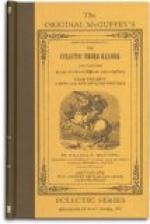And there was mounting in hot haste:
the steed,
The mustering squadron, and the clattering
car
Went pouring forward with impetuous speed,
And swiftly forming in the ranks of war;
And the deep thunder, peal on peal afar;
And near, the beat of the alarming drum
Roused up the soldier ere the morning
star;
While thronged the citizens with terror
dumb,
Or whispering with white lips—“The
foe! They come!
They come!”
And Ardennes waves above them her green
leaves,
Dewy with nature’s tear-drops, as
they pass,
Grieving, if aught inanimate e’er
grieves,
Over the unreturning brave!—alas!
Ere evening to be trodden like the grass,
Which, now, beneath them, but above, shall
grow,
In its next verdure, when this fiery mass
Of living valor, rolling on the foe,
And burning with high hope, shall molder, cold and
low
Last noon beheld them full of lusty life,
Last eve in beauty’s circle proudly
gay,
The midnight brought the signal sound
of strife,
The morn, the marshaling in arms,—the
day,
Battle’s magnificently stern array!
The thunderclouds close o’er it,
which when rent,
The earth is covered thick with other
clay,
Which her own clay shall cover, heaped
and pent,
Rider and horse,—friend, foe,—in
one red burial blent.
—Byron.
Notes.—The Battle of Waterloo was fought on June 18th, 1815, between the French army on one side, commanded by Napoleon Bonaparte, and the English army and allies on the other side, commanded by the Duke of Wellington. At the commencement of the battle, some of the officers were at a ball at Brussels, a short distance from Waterloo, and being notified of the approaching contest by the cannonade, left the ballroom for the field of battle.
The wood of Soignies lay between the field of Waterloo and Brussels. It is supposed to be a remnant of the forest of Ardennes.
CXX. “WITH BRAINS, SIR.” (417)
John Brown, 1810-1882, was born in Lanarkshire, Scotland, and graduated at the University of Edinburgh. His father was John Brown, an eminent clergyman and the author of several books. Dr. Brown’s literary reputation rests largely upon a series of papers contributed to the “North British Review.” “Rab and his Friends,” a collection of papers published in book form, is the most widely known of all his writings. ###
“Pray, Mr. Opie, may I ask you what you mix your colors with?” said a brisk dilettante student to the great painter. “With brains, sir,” was the gruff reply—and the right one. It did not give much of information; it did not expound the principles and rules of the art; but, if the inquirer had the commodity referred to, it would awaken him; it would set him agoing, athinking, and a-painting to good purpose. If he had not the wherewithal, as was likely enough, the less he had to do with colors and their mixture the better.




